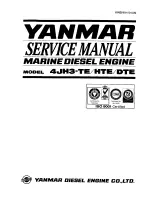
8
A 700cc or 24 oz. fuel tank gives approximately 10 minutes
running time, with variations according to throttle setting,
propeller size and fuel used. Use muffler pressurization and
locate the tank so that its centre line is 10-15mm below the
level of the needle-valve. Also, position the tank as close to
the engine as possible, i.e. immediately behind the firewall.
Be sure to use a pressurized fuel system by connecting the muffler
pressure nipple to the vent-pipe of the fuel tank.
FUEL TANK LOCATION
GLOWPLUGS
Since the compatibility of glowplug and fuel may have a
marked effect on performance and reliability, it would be
worthwhile to try different heat range glowplugs.
Recommended O.S. plugs are Nos. 8 and A5.
Carefully install the plug finger-tight, before final tightening
with the correct size plug wrench.
If the model is left unattended with the fuel tank
filled, fuel may flow into the carburetor, causing it
to "flood" the engine and making it difficult to start.
Take appropriate action to prevent this, e.g. shut
off the needle-valve or pinch the fuel delivery tube
with a suitable clip.
Note:
10-15mm
Locate the fuel tank as close as
possible to the engine.
The role of the glowplug
Glowplug life
Particularly in the case of very high performance engines,
glowplugs must be regarded as expendable items.
Fit a plug suitable for the engine.
Use fuel containing a moderate percentage of nitromethane
unless more is essential for racing events.
Do not run the engine too lean and do not leave the battery
connected while adjusting the needle.
However, plug life can be extended and engine performance
maintained by careful use, i.e.:
With a glowplug engine, ignition is initiated by the application
of a 1.5-volt power source. When the battery is disconnected,
the heat retained within the combustion chamber remains
sufficient to keep the plug filament glowing, thereby continuing
to keep the engine running. Ignition timing is 'automatic' :
under reduced load, allowing higher rpm, the plug becomes
hotter and, appropriately, fires the fuel/air charge earlier;
conversely, at reduced rpm, the plug become cooler and
ignition is retarded.
Apart from when actually burned out, a plug may need to be
replaced because it no longer delivers its best performance,
such as when:
When to replace the glowplug
Filament surface has roughened and turned white.
Filament coil has become distorted.
Foreign matter has adhered to filament or plug body has
corroded.
Engine tends to cut out when idling.
Starting qualities deteriorate.
•
•
•
•
•
•
•
•
9
!
!
FUEL
Model engine fuel is poisonous. Do not allow it to
come into contact with the eyes or mouth. Always
store it in a clearly marked container and out of
the reach of children.
Model engine fuel is also highly flammable. Keep it
away from open flame, excessive heat, sources of
sparks, or anything else which might ignite it.
Do not smoke, or allow anyone else to smoke,
near to it.
Select, by practical tests, the most suitable fuel from among
the best quality fuels available in your country for model use.
For the best performance, a fuel containing 5% to 20% nitro-
methane is preferable. Lubricants may be either castor-oil or a
suitable synthetic oil ( or a blend of both ) provided that they
are always of top quality.
For consistent performance and long engine life, it is essential
to use fuel containing AT LEAST 18% lubricant by volume.
Some fuels containing coloring additives tend to deteriorate
and may adversely affect running qualities.
Once a satisfactory fuel has been selected and used for a
while, it may be unwise to needlessly change the brand or
type. In any engine, a change of fuel may cause carbon de-
posits in the combustion chamber or on the piston head to be-
come detached and lodged elsewhere, with the risk of this
causing unreliable operation for a while. If, however, the
adoption of a different fuel is unavoidable, check the engine
for the first few flights on the new fuel, by temporarily reverting
to the running-in procedure.
18x10-12, 20x8-10
!
PROPELLER
The suitability of the prop depends on the size and weight of
the model and type of flying. Determine the best size and type
after the engine has been run in. Check the balance of the
propeller before installing on the engine. Unbalanced
propellers cause vibration and loss of power. Wooden
propellers are to be preferred. Some nylon propellers are not
strong enough to withstand the high power output of these
engines and a thrown blade can be very dangerous.
Never touch, or allow any object to come into
contact with, the rotating propeller and do not
crouch over the engine when it is running.
Sports & Scale
PROPELLER & SPINNER ATTACHMENT
Ream the propeller shaft hole to
9.6mm bore with an appropriate
reamer, checking that the hole is exactly centered.
Install the prop to the engine shaft, followed by the retaining
washer and prop nut and tighten firmly with a 17mm
wrench.
Obviously, this can be very
hazardous. To eliminate such
dangers, the O.S. Safety Locknut
Assembly was devised.
Install this as follows:
Lock Nut
Propeller Washer
Propeller Nut
1.
2.
3. Add the special tapered and slotted locknut and secure
with a 14mm wrench while holding the prop nut with the
17mm wrench.





























